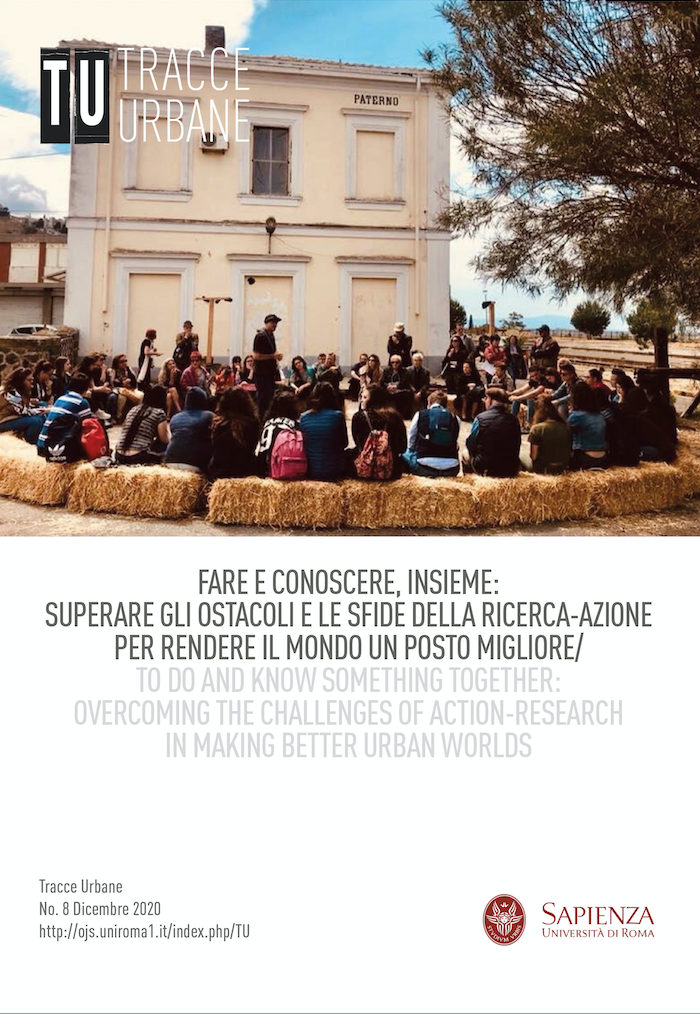Collaborative problem-solving through PhotoVoice: helping community organizations move from network building to action in Havana, Cuba
DOI:
https://doi.org/10.13133/2532-6562_4.8.17044Parole chiave:
PhotoVoice, Community-Based Participatory Research, Community OrganizationsAbstract
Questo articolo descrive il passaggio dalla costruzione della rete all’azione, nel quadro di ricerca partecipativa a livello comunitario. In particolare, descrivo lo sviluppo di una rete di organizzazioni comunitarie all’Avana (Cuba), e in che modo è stata utilizzata la metodologia del PhotoVoice come strumento collaborativo per scoprire e affrontare alcune sfide comuni, rimaste anche dopo la creazione della rete. Il nostro progetto PhotoVoice ha inteso 1) formare un legame più coeso tra le organizzazioni partecipanti e 2) fornire loro un ‘linguaggio condiviso’ per comunicare alcune delle loro esperienze, identificare e iniziare a risolvere alcune circostanze di fondo o trascurate. Il progetto PhotoVoice è culminato in una esposizione di 21 foto e didascalie che hanno descritto le maggiori opportunità, sfide e obiettivi di ogni organizzazione. Il processo – dai nostri primi workshop alla mostra finale – ha messo in luce alcune considerazioni chiave per le organizzazioni partecipanti e per molte altre organizzazioni della rete.
This article describes the movement from network building to action within a Community-Based Participatory Research framework. Specifically, I describe the development of a network of community organizations in Havana, Cuba, and how we utilized the PhotoVoice methodology as a collaborative tool to discover and address some common challenges that remained even after the network was established. Our PhotoVoice project sought to 1) form a more cohesive bond between the participating organizations and 2) give them a ‘shared language’ to communicate some of their experiences and identify and begin to resolve some underlying or overlooked circumstances. The PhotoVoice project culminated in a gallery of 21 photos and captions that described each organization’s greatest opportunity, challenge, and goals. The process – from our first workshops to the final exhibition – revealed some key considerations for the participating organizations as well as many other organizations in the network.
Riferimenti bibliografici
Cameron J. (2007). «Linking Participatory Research to Action: Institutional challenges». In: Kindon S., Pain R., Kesby M. (eds.), Participatory Action Research Approaches and Methods. New York: Routledge.
Cartwright E., Schow D. (2016). «Anthropological Perspectives on Participation in CBPR: Insights From the Water Project, Maras, Peru». Qualitative Health Research, 26: 136–140. Doi: 10.1177/1049732315617480.
Cubadebate. (2019, September 11). «Presidente Díaz-Canel informa medidas coyunturales ante situación energética de Cub». Text available on the website: http://www.cubadebate. cu/noticias/2019/09/11/presidente-diaz-canel-informa- nuevas-medidas-ante-situacion-energetica-de-cuba/#. X1wKQWhKhPZ. Date of consultation: September 12, 2019.
de la Fuente A. (2001). «Recreating racism: Race and Discrimination in Cuba’s ‘Special period’». Socialism and Democracy, 15: 65–91. Doi: 10.1080/08854300108428278.
Enria L. (2016). «Co-producing knowledge through participatory theatre: reflections on ethnography, empathy and power». Qualitative Research, 16(3): 319–329. Doi: 10.1177/1468794115615387.
Espina Prieto M. (2013). «La política social cubana para el manejo de la desigualdad». Cuban Studies, 41: 20–38. Doi: 10.1353/cub.2010.0007.
Fernandes S. (2006). Cuba Represent!: Cuban Arts, State Power, and the Making of New Revolutionary Cultures. Durham: Duke University Press.
Freire P. (1993). Pedagogy of the oppressed. London: Continuum Publishing Company.
Hergenrather K. C., Rhodes S. D., Cowan C. A., Bardhoshi G., Pula S. (2009). «Photovoice as Community-Based Participatory Research: a Qualitative Review». American Journal of Health Behavior, 33(6): 686–698. Doi: 10.5993/AJHB.33.6.6.
Kemmis S., McTaggart R., Nixon R. (2014). The Action Research Planner: Doing Critical Participatory Action Research. New York: Springer.
Mesa-lago C. (2002). «Las crecientes disparidades económicas y sociales en Cuba: Impacto y recomendaciones para el cambio». Cuba Transition Report. Miami: Institue for Cuban and Cuban- American Studies at the University of Miami.
Padilla M., Matiz-Reyes A., Colón-Burgos J. F., Varas-Díaz N., Vertovec J. (2019). «Adaptation of PhotoVoice methodology to promote policy dialog among street-based drug users in Santo Domingo, Dominican Republic». Arts and Health, 11(2): 147–162. Doi: 10.1080/17533015.2018.1444647.
Pardo I., Prato G. B., eds. (2012). Anthropology in the City: Methodology and Theory. Burlington: Ashgate.
Pauwels L. (2015). «‘Participatory’ Visual Research Revisited: A Critical-Constructive Assessment of Methodological and Social Activist Tenets». Ethnography 16: 95–117. Doi: 10.1177/1466138113505023.
WangC.C.,BurrisM.A.(1997).«Photovoice:Concept,Methodology, and Use for Participatory Needs Assessment». Health Education & Behavior, 24(3): 369–387. Doi: 10.1177/109019819702400309.
##submission.downloads##
Pubblicato
Come citare
Licenza
NOTA DI COPYRIGHT
Proposta di licenza Creative Commons
1. Proposta per riviste Open Access
Gli autori che pubblicano su questa rivista accettano le seguenti condizioni:
Gli autori mantengono i diritti sulla loro opera e cedono alla rivista il diritto di prima pubblicazione dell'opera, contemporaneamente licenziata sotto una Licenza Creative Commons - Attribuzione che permette ad altri di condividere l'opera indicando la paternità intellettuale e la prima pubblicazione su questa rivista.
Gli autori possono aderire ad altri accordi di licenza non esclusiva per la distribuzione della versione dell'opera pubblicata (es. depositarla in un archivio istituzionale o pubblicarla in una monografia), a patto di indicare che la prima pubblicazione è avvenuta su questa rivista.
Gli autori possono diffondere la loro opera online (es. in repository istituzionali o nel loro sito web) prima e durante il processo di submission, poiché può portare a scambi produttivi e aumentare le citazioni dell'opera pubblicata (Vedi The Effect of Open Access).


